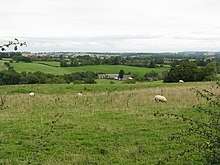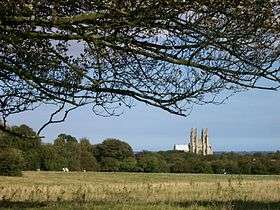Pasture
A pasture (from the Latin pastus, past participle of pascere, "to feed") is a vegetated outdoor land is used for grazing.[1] Pasture lands in the narrow sense are enclosed tracts of farmland, grazed by domesticated livestock, such as horses, cattle, sheep, or swine. The vegetation of tended pasture, forage, consists mainly of grasses, with an interspersion of legumes and other forbs (non-grass herbaceous plants). Pasture is typically grazed throughout the summer, in contrast to meadow which is ungrazed or used for grazing only after being mown to make hay for animal fodder.[2] Pasture in a wider sense additionally includes rangelands, other unenclosed pastoral systems, and land types used by wild animals for grazing or browsing.


Pasture lands in the narrow sense are distinguished from rangelands by being managed through more intensive agricultural practices of seeding, irrigation, and the use of fertilizers, while rangelands grow primarily native vegetation, managed with extensive practices like controlled burning and regulated intensity of grazing.
Soil type, minimum annual temperature, and rainfall are important factors in pasture management. Sheepwalk is an area of grassland where sheep can roam freely. The productivity of sheepwalk is measured by the number of sheep per area. This is dependent, among other things, on the underlying rock.[3] Sheepwalk is also the name of townlands in County Roscommon, Ireland and County Fermanagh, Northern Ireland.
Unlike factory farming, which entails in its most intensive form entirely trough-feeding, managed or unmanaged pasture is the main food source for ruminants. Pasture feeding dominates livestock farming where the land makes crop sowing and/or harvesting difficult, such as in arid or mountainous regions, where types of camel, goat, antelope, yak and other ruminants live which are well suited to the more hostile terrain and very rarely factory farmed. In more humid regions, pasture grazing is managed across a large global area for free range and organic farming. Certain types of pasture suit the diet, evolution and metabolism of particular animals, and their fertilising and tending of the land may over generations result in the pasture combined with the ruminants in question being integral to a particular ecosystem.[4]
Examples of pasture habitats
_Lessinia_VR_Italy_2013-04-01_photo_CTG_ACA_LESSINIA_Paolo_Villa_0055sp_04.jpg)
- Grassland
- Heathland
- Machair
- Maquis
- Moorland
- Potrero (landform)
- Prairie
- Rangeland
- Rough pasture
- Savanna
- Steppe
- Wood pasture
- Veld
See also
Notes
- "pasture". Merriam-Webster Dictionary.
- Gilman, D. C.; Peck, H. T.; Colby, F. M., eds. (1905). . New International Encyclopedia (1st ed.). New York: Dodd, Mead.
- R. Elfyn Hughes, "Sheep Population and Environment in Snowdonia (North Wales)", Journal of Ecology Vol. 46, No. 1, March 1958, 169-189
- "Agricultural biodiversity’s contribution to ecosystem functions" Archived 2015-01-08 at the Wayback Machine Dr. Devra I. Jarvis, CGIAR. Retrieved 2014-12-01
| Wikimedia Commons has media related to Pastures. |
